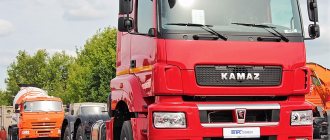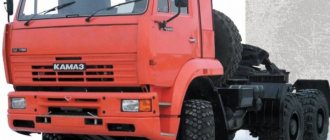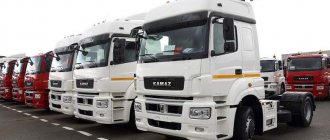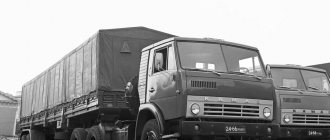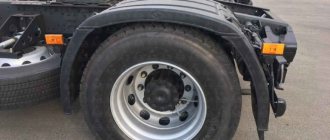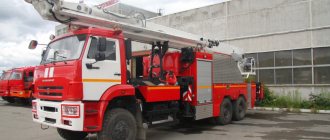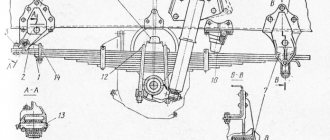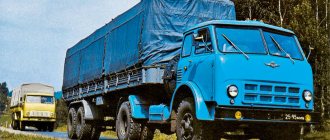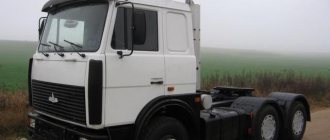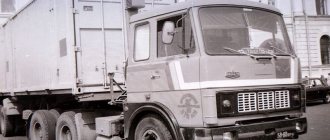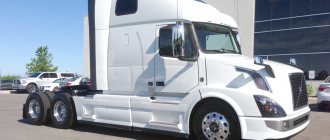Ranged Sloths
Aidar Aleev, Yuri Petrov, photo by the authors and Daniil Minaev
The launch of new generation KAMAZ vehicles with K4 cabs at KAMAZ allowed it to retain its leadership in the truck market. Things didn't get any better in 2018, but at least tensions were eased. Now KAMAZ, in addition to fresh business tools and marketing, will also need fresh design ideas. One of them has already been solved within the framework of the K4 project in the form of a KAMAZ-65208 truck with a lifting rear axle. Now the KAMAZ-65209 truck tractor has been added to it.
The Kama Automobile Plant set an absolute world record for trucks. It still produces the cabin developed in the late 1960s at ZIL. Castling modifications (heavy trucks, military versions) and design palliatives (special crane chassis, light trucks, civilian conversions) only made it possible for a couple of moves to hide the weakness of the auto giant’s position. Classic trucks from Naberezhnye Chelny are already tired of the burden of responsibilities and areas of application. Although KAMAZ’s design decisions are still considered uncontroversial and balanced, the cabin begs to be put in a museum.
The short rise in KAMAZ sales in 2008 was associated with a boom in the transport industry, when freight rates rose. By this time, the Stayer light tractors were launched. However, the cost of owning European, Chinese, American and Japanese cars was no longer a bugbear for regional truckers: they stopped saving on comfort. So the service of “Euro brands” came to the regions for the consumer, which began to crowd out the “Chelny residents” in their traditional beds. Surprisingly, thanks to the new cabs, KAMAZ itself switched to innovative design!
Top for the Thrifty
The KAMAZ-65209 truck tractor in technical perfection closes the line of long-range vehicles, for which the new sub-brand NEO was invented too late at the plant. It’s a shame, but if GAZ has NEXT, then the “kamaxors” (KAMAZs with Mercedes-Benz Axor cabs) should have had a new designation from childhood. However, instead, KAMAZ played with German associations with a confusing set of numbers. So KAMAZ-65209 acquired the second designation T2640.
NEO does not belong to the line of classic budget transport solutions, which includes “Stayers”, military “Mustangs” and low-frame 6-ton “Kamazyats” of the 4308 family. But at the optimal price, they enter into intense competition with budget Eurotrucks, which were previously actively purchased by retail. The advantages of a lifting axle became all too obvious during the crisis. A reduction in operating costs for fuel by 2–3% (and this is the minimum!) will compensate for the increase in prices for diesel fuel. Increased mileage on non-drive rear axle tires will reduce long-term operating costs. Optimally, it is possible to work on roads with an axle load limit of 10 tons on roads with unstable load-bearing capacity, or in cases with weight restrictions (bridges and overpasses) in the regions. For example, according to the national project “Safe and High-Quality Highways” on federal highways in Russia, the number of frames of the automated weight and dimensional control system (ASVGK) will be increased from 27 to 387. And there is confidence that the limit on the middle axle of 10 tons for road trains with a total weight of 40 tons is motivated inspectors will be monitored specifically.
KAMAZ-65209 for the Krasnoyarsk Territory and Khakassia
For cargo carriers in Yenisei Siberia, a modern truck tractor based on Mercedes/Daimler with a lifting rear axle is ideal in the following cases:
- When the load structure of flights is constantly changing (for example, a semi-trailer fully loaded with petroleum products or inert materials in one direction, and almost always empty back).
- If it is necessary to ensure a low landing of a semi-trailer, the efficiency and maneuverability of a two-axle truck, while being able to carry out transportation with the maximum permissible load on the road surface per axle, as with three-axle tractors.
At the same time, if your cargo transportation structure involves a stable large load, or in addition to the main flat highways you often have to overcome snow-covered mountain roads (for example, in Tuva or Altai), then we recommend taking a closer look at the KAMAZ-65206 model, and in cases transportation of especially heavy semi-trailers on the KAMAZ-65806 model.
KAMAZ-65209 is a good compromise choice for most long-haul carriers.
There is a similar functional model of a tractor with a lifting rear axle from the flagship K5/P5 line under the symbol KAMAZ-65659.
The cost of the tractor depends on the specific configuration and additional options. Call us on tel. in Krasnoyarsk 2-555-004 or request a call back: and we will advise you on modifications, delivery options and current prices for KAMAZ-65209.
Cabin for the far shoulder
Only the lazy didn’t kick the new KAMAZ cabs. But what was wrong with the Mercedes-Benz Actros! The K4 cabin with increased space for the new tractor was chosen taking into account the wishes of regional truckers, for whom the car becomes a second home. The volume increased to 8 m3 (versus 5.0 and 6.5 m3 for classic KAMAZ trucks) due to the high roof and 4-point suspension already implies comfortable work on the far shoulder. The spacious cabin provides a larger supply of air and better circulation: its volume is only 1.5 cubic meters less than a sleeping car compartment. In addition, the large volume prevents the interior from quickly cooling down when the doors are opened.
The roof hatch is equipped with a mosquito net, and above the windshield there are two shelves with a central lockable box. There are plenty of drawers and niches, but the picture is crowned by a central tide on the instrument panel console with three recesses and an ashtray. Anatomically sprung air-suspended seats and an almost flat floor allow you to move around the cabin literally without bending your head. The second hanging shelf is available upon request only.
The instrument cluster is typical for the K4 series and is equipped with a central display, while a tachograph and GLONASS are standard equipment. The cabin has 4 lights on the ceiling and walls, as well as plugs for electrical appliances for 12 and 24 V. Additional equipment includes an audio system, electronic tachograph, air conditioning and auxiliary cabin heater.
Not extra strength
Saving fuel by 3-4% for a modern truck is already a great luxury, and the best engineering minds in the world are struggling with these indicators. But thanks to the lifting axle, it is possible to achieve a reduction in consumption of 5–7%, which, with rising prices for diesel fuel, becomes a significant indicator.
The engine power was not stifled for the sake of efficiency. In practice, the cargo carrier is concerned with high tempo and maintaining high tempo of traffic. Trucks do not drive on paper maps, but get stuck in transit traffic jams, and hills from the Carpathians to Transbaikalia are not uncommon on highways. On long climbs, acceleration on two-lane highways in ragged mode through a series of towns and villages, the fuel consumption of a more powerful engine will be even lower than that of the most economical one, since it does not need to be overclocked. In general, a road train weighing over 30 tons in traffic requires a torquey engine with a reserve of torque. You also need to make allowances for power loss in mountainous areas. Therefore, the 400-horsepower 6-cylinder 11.97-liter turbodiesel OM 457LA.V/3 with Euro 5 environmental standard became an acceptable compromise. It allows you to quickly start up to the permitted speed of 90 km/h. Confident acceleration and controlled movement are the key to safe driving.
Star power unit
So, under the mid-height cab with a berth, a Mercedes engine OM 457LA.V / 3 is installed. This is an in-line 6-cylinder diesel engine with a displacement of 11.97 liters. The range of such power engines includes three power settings: 315 kW (428 hp), 295 kW (401 hp), as was the case on the tested car, and 260 kW (354 hp). All these power units are inherited from the Mercedes-Benz Axor and, thanks to BlueTec technology, as well as the Telligent control and diagnostic system, comply with exhaust gas toxicity standards - Euro 5, Euro 6.
The Telligent engine management system with injection pressures of up to 2300 bar, working on the pump-pipe-injector principle, ensures optimized fuel combustion. The engine design is typical for the stellar German concern: separate cylinder heads, timing drive on the flywheel side, 4 valves per cylinder. During the test, the engine proved to be quiet and dynamic, in theory, it should not fall flat on its face, and when the chassis is overgrown with a superstructure: the calculated technically permissible gross weight of our vehicle will be 26 tons, it is not planned for more than 44 tons for a possible road train . For such a power supply, this is the optimal ratio between power and fuel consumption, by the way, this is evidenced by the purely “plain-urban” gear ratio of the main pair - 3.077, while the declared maximum surmountable slope of the car is 25%.
The mechanical 12-speed gearbox with automated control AS-Tronic ZF 12AS2130 TD is designed to operate with torque up to 2100 Nm. The engine in our case has a maximum torque of 2040 Nm, so there is even a small technical reserve.
Two solutions for one driver
The main thing is to be able to realize the power reserve. Since driving with a 35-ton semi-trailer on the far shoulder requires long-term and extreme concentration from the driver, the design included option 65209-002-87 with a manual 12-speed ZF 12AS2135 TD gearbox with automated AS-Tronic control, which is designed to work with engine with torque up to 2100 Nm. The OM 457LA engine has a maximum torque of 2000 Nm, which even leaves a technical reserve.
However, there is also a standard option with a mechanical 16-speed (with divider) gearbox ZF 16S2220 TD for configuration 65209-001-87. In terms of torque reserve, it gives the engine a head start of 220 Nm.
There is a hill-start assist button in the cab to help reduce slipping when driving uphill on icy or sandy roads. When you press it, the “sloth” rises up, the load on the drive axle increases (the coefficient of adhesion weight increases), which improves contact with the road.
A single-link cardan transmission transmits torque to the second drive axle with a hypoid final drive and differential lock, which is borrowed along with the suspension from KAMAZ-5490 NEO.
The chassis uses disc brakes on all wheels with electro-pneumatic drive (EBS), exchange rate stability system (ESP) and traction control (ASR).
Features of KAMAZ-65209 operation
The tractor is equipped with load sensors, and the control of the rear lift axle is automated. With the idler raised, a drive axle load of up to 9.7 tons is permissible, and if the semi-trailer fits these parameters, you can continue driving in an economical two-axle version.
If the load on the axle exceeds 9.7 tons, then the lifting axle is automatically lowered, and the load is already distributed over two points, increasing the vehicle's carrying capacity, and the automation controls the axle so that the load is distributed correctly.
There is also manual control: if necessary, you can independently increase or decrease the load.
This can be useful when starting off, slipping, on slippery roads or off-road. To do this, use a special key on the control panel: when you press it, the sloth can be raised for a short time, the entire torque force is transferred to one drive axle for a while, which allows you to solve the problem.
Savings on axles
The front suspension on small leaf springs is equipped with silent blocks instead of oil cans, which increased the service life and the need for maintenance. Instead of 7-ton axles, Hande Axle axles with a technically permissible load of 9 tons are used.
For a long time, trucks with a suspended rear axle looked like black sheep on highways not only in Russia, but also in Eastern Europe. At a time when freight rates per ton-kilometer were twice as high as operating costs, talking about fuel and tire consumption was a subject of debate only for the most advanced truckers. But as soon as the margin in cargo transportation fell, operators began to look for savings reserves. Using the example of one car, a daily saving of 1–2 liters of diesel fuel is imperceptible. But within the framework of a large fleet park (with 10 cars or more), from 150 to 200 thousand rubles accumulate in a year!
Ease of operation and maintenance KAMAZ 65209-S5
The manufacturer claims that the vehicle's service life is 1 million km, with 200 thousand km of mileage covered under warranty. Maintenance is carried out every 80 thousand km. Performance and high technical characteristics are maintained at ambient temperatures from -50 to +40 degrees.
Operating the truck will not require significant investment. On average, 1 km of mileage costs about 20 rubles, and foreign competitors require costs of 21-27 rubles.
Materials used were published on the websites avtospravochnaya.com and justdepot.ru
You can add to the savings the safety of your tires.
The lifting rear axle with single-pitch tires and the lifting mechanism with the ECAS electronic control system were developed by NPO ROSTAR, and the pneumatic algorithm was developed by Wabco. The location of the lifting axle behind the drive axle reduces the turning radius when lifting it.
The total load on the driving middle and lifting axles is 15 tons, which meets the requirements for highways designed for an axle load of 10 tons. It is interesting that 30 years ago the Finnish company Nummek Oy used a lifting axle with double tires. But then the customers (usually Soviet-Finnish joint ventures in the construction industry) set the task of using a 6x4 wheel arrangement.
The load distribution on the drive axle and lifting axle is disproportionate. The redistribution share of 53/47% made it possible to load the front axle as much as possible. With the rear axle raised, the drive axle can be loaded with 9.7 tons and continue driving in two-axle form. This will save fuel and protect the tread from abrasion, but will maintain maneuverability (turning radius 8 m), which is inherent in a two-axle tractor. When the load on the drive axle increases above 9.7 t, the lifting axle is lowered and takes on part of the load.
The axle itself and the lifting mechanism with the ECAS electronic control system were developed by NPO ROSTAR, a long-time partner of KAMAZ, and the pneumatic operating algorithm is provided by Wabco components.
By pressing a button on the remote control or panel, you can briefly increase or decrease the load on the drive axle to overcome light off-road conditions or slip on slippery surfaces.
Technical characteristics of KAMAZ-65209-S5 Neo (6×2-2) T2640
| Equipment | 65209-001-87 S5 | 65209-002-87 S5 |
| Vehicle curb weight, kg | 8840 | |
| Distribution of curb weight along axles, kg | 4730/ 4110 | |
| Load on fifth wheel coupling, kg | 17 160 (12 660)* | |
| Gross vehicle weight, kg | 26 000 (21 500)* | |
| Distribution of total mass along axes, kg | 7000/ 11 500/ 7500 (6500/ 8000/ 7000)* | |
| Gross weight of towed semi-trailer, kg | 35 160 (35 085)* | |
| Gross weight of the road train, kg | 44 000 | |
Engine:
| Mercedes-Benz OM 457LA.V/3 (Euro 5), turbodiesel, I-6, 11,967,401 at 1900 min-1 2000 at 1100 min-1 | |
| Fuel tank capacity, l | 495 | |
| Transmission | ZF 16S2220 TD, mechanical | ZF 12AS2135 TD, mechanical with automated control |
| Number of forward/reverse gears | 16/ 1 | 12/ 1 |
| Clutch | Single disc, diaphragm mod. MFZ 430 | |
| Braking mechanisms of all wheels | Disk | |
| Rim size | 9,00–22,5 | |
| Tire size | 315/70 R22.5 | |
* For roads designed for an axle load of 10 t/axle.
Purpose and advantages of KAMAZ-65209
The presence of a lifting rear axle in this model makes it possible to adapt to specific conditions of cargo transportation along highways in order to distribute pressure on the road surface and optimize overall operating costs.
KAMAZ 65209 allows you to significantly save fuel when driving as part of a road train without a full load and when traveling without a semi-trailer.
- Compared to the two-axle KAMAZ-5490 (4×2), this tractor allows the maximum semi-trailer load on the fifth wheel to be increased to 17.1 tons, while having the same “low saddle” (1150 mm).
- Compared to the three-axle KAMAZ-65206 with two driven axles (6x4), the KAMAZ-65209 model can significantly reduce fuel consumption and tire wear, with the same weight of cargo transported in the semi-trailer. Also, when the sloth is raised, the maneuverability (turning radius of 8 m) inherent in a two-axle tractor appears.
Stanovoy Ridge
The KAMAZ frame with an installation length of 7790 mm is rolled in Naberezhnye Chelny from imported rolled steel, the brackets and hitch are secured using high-strength bolts. The front part of the left side member is used to mount a bracket that combines the fastening of the front springs and the cab. Power steering is also installed on it. Integral brackets reduce weakening and twisting of the side members at this location. This improves handling and protects the frame from deformation.
A 500 liter fuel tank, providing a range of up to 1,500 km, is mounted on the right side of the frame, and a spare wheel holder is optionally mounted on the left side. As a standard, the spare tire will have to be kept on the saddle or semi-trailer. To comply with Euro 5 environmental standards, the car is equipped with a 70 liter AdBlue tank.
The average height of the chassis to the upper flange of the side member is 940 mm. It can be mounted with a fifth wheel from one of three companies (Orlandi, Jost or SAF-Holland) under a standard 2-inch coupling pin with a diameter of 50.8 mm.
The height of the SSU is designed to work with semi-trailers of the most popular standard with a nominal height of the support platform of 1150 mm. However, modernization for taller semi-trailers is not excluded.
Oh, how many of you were there?
Lift axles have been used on commercial vehicles since the early 1950s to save fuel and preserve the chassis. The first Soviet truck with a lifting axle, Sisu, was released only in 1967, and then by order of the Finnish exporter Konela Oy. But even when the MAZ-516 went into production two years later, the idea never received proper distribution. The benefits of saving diesel fuel and reducing tire wear did not find understanding in the minds of Soviet car sloppiness, while these cars were in demand among the zealous Finns. In the early 1980s, Nummek Oy equipped the KAMAZ-5315 chassis with lifting axles, producing 6x4-2 and 6x2-2 versions of the two-axle truck. Using the resulting base, Hankkija Oy and Tehtaat Oy produced MKT milk tankers for Valio, and the Finn-Stroi Oy joint venture ordered multi-lift versions for swap bodies. But as we see, neither in the 1980s nor in the 1990s did domestic automakers or exporters use lifting axles on truck tractors!
KAMAZ Group of Companies
The group is the largest automobile corporation in the Russian Federation. Also, it is one of the 20 leading global manufacturers of heavy trucks. According to estimates for 2016, the company sold about 35 thousand trucks, which is 20% more than in 2015. In total, KAMAZ produced more than 2,200 million vehicles from the assembly line.
Today, the company includes 89 companies in Russia, the CIS and abroad. And it produces a wide range of cargo equipment: trucks, trailers, tractors, buses and much more.
